+ Open data
Open data
- Basic information
Basic information
| Entry |  | |||||||||
|---|---|---|---|---|---|---|---|---|---|---|
| Title | Structure of REGN7663-Fab bound CXCR4 | |||||||||
 Map data Map data | ||||||||||
 Sample Sample |
| |||||||||
 Keywords Keywords |  GPCR / GPCR /  chemokine receptor / chemokine receptor /  antibody / antibody /  fab / fab /  SIGNALING PROTEIN-IMMUNE SYSTEM complex SIGNALING PROTEIN-IMMUNE SYSTEM complex | |||||||||
| Function / homology |  Function and homology information Function and homology informationC-X-C motif chemokine 12 receptor activity / regulation of viral process / positive regulation of vascular wound healing / positive regulation of macrophage migration inhibitory factor signaling pathway / positive regulation of mesenchymal stem cell migration / neuron recognition / response to ultrasound / response to tacrolimus / telencephalon cell migration / C-X-C chemokine receptor activity ...C-X-C motif chemokine 12 receptor activity / regulation of viral process / positive regulation of vascular wound healing / positive regulation of macrophage migration inhibitory factor signaling pathway / positive regulation of mesenchymal stem cell migration / neuron recognition / response to ultrasound / response to tacrolimus / telencephalon cell migration / C-X-C chemokine receptor activity / Specification of primordial germ cells / CXCL12-activated CXCR4 signaling pathway /  myosin light chain binding / myosin light chain binding /  myelin maintenance / positive regulation of vasculature development / myelin maintenance / positive regulation of vasculature development /  regulation of programmed cell death / C-C chemokine receptor activity / endothelial tube morphogenesis / endothelial cell differentiation / C-C chemokine binding / Signaling by ROBO receptors / regulation of programmed cell death / C-C chemokine receptor activity / endothelial tube morphogenesis / endothelial cell differentiation / C-C chemokine binding / Signaling by ROBO receptors /  regulation of chemotaxis / cellular response to organonitrogen compound / positive regulation of chemotaxis / Formation of definitive endoderm / positive regulation of dendrite extension / anchoring junction / Chemokine receptors bind chemokines / dendritic cell chemotaxis / positive regulation of oligodendrocyte differentiation / epithelial cell development / cell leading edge / cellular response to cytokine stimulus / detection of temperature stimulus involved in sensory perception of pain / regulation of calcium ion transport / Binding and entry of HIV virion / regulation of chemotaxis / cellular response to organonitrogen compound / positive regulation of chemotaxis / Formation of definitive endoderm / positive regulation of dendrite extension / anchoring junction / Chemokine receptors bind chemokines / dendritic cell chemotaxis / positive regulation of oligodendrocyte differentiation / epithelial cell development / cell leading edge / cellular response to cytokine stimulus / detection of temperature stimulus involved in sensory perception of pain / regulation of calcium ion transport / Binding and entry of HIV virion /  small molecule binding / small molecule binding /  regulation of cell adhesion / regulation of cell adhesion /  coreceptor activity / detection of mechanical stimulus involved in sensory perception of pain / cardiac muscle contraction / cell chemotaxis / coreceptor activity / detection of mechanical stimulus involved in sensory perception of pain / cardiac muscle contraction / cell chemotaxis /  neurogenesis / response to activity / neurogenesis / response to activity /  ubiquitin binding / G protein-coupled receptor activity / calcium-mediated signaling / ubiquitin binding / G protein-coupled receptor activity / calcium-mediated signaling /  neuron migration / neuron migration /  brain development / response to virus / cellular response to xenobiotic stimulus / late endosome / virus receptor activity / positive regulation of cold-induced thermogenesis / brain development / response to virus / cellular response to xenobiotic stimulus / late endosome / virus receptor activity / positive regulation of cold-induced thermogenesis /  actin binding / positive regulation of cytosolic calcium ion concentration / G alpha (i) signalling events / cytoplasmic vesicle / actin binding / positive regulation of cytosolic calcium ion concentration / G alpha (i) signalling events / cytoplasmic vesicle /  lysosome / lysosome /  early endosome / response to hypoxia / positive regulation of cell migration / early endosome / response to hypoxia / positive regulation of cell migration /  immune response / immune response /  inflammatory response / G protein-coupled receptor signaling pathway / external side of plasma membrane / apoptotic process / inflammatory response / G protein-coupled receptor signaling pathway / external side of plasma membrane / apoptotic process /  ubiquitin protein ligase binding / ubiquitin protein ligase binding /  cell surface / protein-containing complex / extracellular exosome / cell surface / protein-containing complex / extracellular exosome /  plasma membrane / plasma membrane /  cytoplasm cytoplasmSimilarity search - Function | |||||||||
| Biological species |   Homo sapiens (human) Homo sapiens (human) | |||||||||
| Method |  single particle reconstruction / single particle reconstruction /  cryo EM / Resolution: 3.1 Å cryo EM / Resolution: 3.1 Å | |||||||||
 Authors Authors | Saotome K / McGoldrick LL / Franklin MC | |||||||||
| Funding support |  United States, 1 items United States, 1 items
| |||||||||
 Citation Citation |  Journal: Biorxiv / Year: 2024 Journal: Biorxiv / Year: 2024Title: Structural insights into CXCR4 modulation and oligomerization Authors: Saotome K / McGoldrick LL / Ho J / Ramlall T / Shah S / Moore MJ / Kim JH / Leidich R / Olson WC / Franklin MC | |||||||||
| History |
|
- Structure visualization
Structure visualization
| Supplemental images |
|---|
- Downloads & links
Downloads & links
-EMDB archive
| Map data |  emd_41892.map.gz emd_41892.map.gz | 97.2 MB |  EMDB map data format EMDB map data format | |
|---|---|---|---|---|
| Header (meta data) |  emd-41892-v30.xml emd-41892-v30.xml emd-41892.xml emd-41892.xml | 17.1 KB 17.1 KB | Display Display |  EMDB header EMDB header |
| Images |  emd_41892.png emd_41892.png | 114.4 KB | ||
| Filedesc metadata |  emd-41892.cif.gz emd-41892.cif.gz | 6 KB | ||
| Others |  emd_41892_half_map_1.map.gz emd_41892_half_map_1.map.gz emd_41892_half_map_2.map.gz emd_41892_half_map_2.map.gz | 95.6 MB 95.6 MB | ||
| Archive directory |  http://ftp.pdbj.org/pub/emdb/structures/EMD-41892 http://ftp.pdbj.org/pub/emdb/structures/EMD-41892 ftp://ftp.pdbj.org/pub/emdb/structures/EMD-41892 ftp://ftp.pdbj.org/pub/emdb/structures/EMD-41892 | HTTPS FTP |
-Related structure data
| Related structure data | 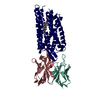 8u4rMC 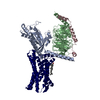 8u4nC 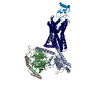 8u4oC 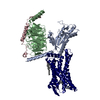 8u4pC 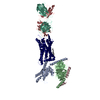 8u4qC 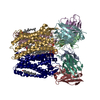 8u4sC  8u4tC C: citing same article ( M: atomic model generated by this map |
|---|---|
| Similar structure data | Similarity search - Function & homology  F&H Search F&H Search |
- Links
Links
| EMDB pages |  EMDB (EBI/PDBe) / EMDB (EBI/PDBe) /  EMDataResource EMDataResource |
|---|---|
| Related items in Molecule of the Month |
- Map
Map
| File |  Download / File: emd_41892.map.gz / Format: CCP4 / Size: 103 MB / Type: IMAGE STORED AS FLOATING POINT NUMBER (4 BYTES) Download / File: emd_41892.map.gz / Format: CCP4 / Size: 103 MB / Type: IMAGE STORED AS FLOATING POINT NUMBER (4 BYTES) | ||||||||||||||||||||
|---|---|---|---|---|---|---|---|---|---|---|---|---|---|---|---|---|---|---|---|---|---|
| Voxel size | X=Y=Z: 0.85 Å | ||||||||||||||||||||
| Density |
| ||||||||||||||||||||
| Symmetry | Space group: 1 | ||||||||||||||||||||
| Details | EMDB XML:
|
-Supplemental data
-Half map: #1
| File | emd_41892_half_map_1.map | ||||||||||||
|---|---|---|---|---|---|---|---|---|---|---|---|---|---|
| Projections & Slices |
| ||||||||||||
| Density Histograms |
-Half map: #2
| File | emd_41892_half_map_2.map | ||||||||||||
|---|---|---|---|---|---|---|---|---|---|---|---|---|---|
| Projections & Slices |
| ||||||||||||
| Density Histograms |
- Sample components
Sample components
-Entire : REGN7663 Fab-bound CXCR4
| Entire | Name: REGN7663 Fab-bound CXCR4 |
|---|---|
| Components |
|
-Supramolecule #1: REGN7663 Fab-bound CXCR4
| Supramolecule | Name: REGN7663 Fab-bound CXCR4 / type: complex / ID: 1 / Parent: 0 / Macromolecule list: #1-#3 |
|---|---|
| Source (natural) | Organism:   Homo sapiens (human) Homo sapiens (human) |
-Macromolecule #1: REGN7663 Fab light chain
| Macromolecule | Name: REGN7663 Fab light chain / type: protein_or_peptide / ID: 1 / Number of copies: 1 / Enantiomer: LEVO |
|---|---|
| Source (natural) | Organism:   Homo sapiens (human) Homo sapiens (human) |
| Molecular weight | Theoretical: 24.185904 KDa |
| Recombinant expression | Organism:   Cricetulus griseus (Chinese hamster) Cricetulus griseus (Chinese hamster) |
| Sequence | String: DVVMTQSPLS LPVTLGQPAS ISCRSSQSLV YTDGNTYLNW FQQRPGQSPR RLIYKVSNRD SGVPDRFSGS GSGTDFTLKI SRVEAEDVG FYYCMQNTHW PLTFGGGTKV EIKRTVAAPS VFIFPPSDEQ LKSGTASVVC LLNNFYPREA KVQWKVDNAL Q SGNSQESV ...String: DVVMTQSPLS LPVTLGQPAS ISCRSSQSLV YTDGNTYLNW FQQRPGQSPR RLIYKVSNRD SGVPDRFSGS GSGTDFTLKI SRVEAEDVG FYYCMQNTHW PLTFGGGTKV EIKRTVAAPS VFIFPPSDEQ LKSGTASVVC LLNNFYPREA KVQWKVDNAL Q SGNSQESV TEQDSKDSTY SLSSTLTLSK ADYEKHKVYA CEVTHQGLSS PVTKSFNRGE C |
-Macromolecule #2: REGN7663 Fab heavy chain
| Macromolecule | Name: REGN7663 Fab heavy chain / type: protein_or_peptide / ID: 2 / Number of copies: 1 / Enantiomer: LEVO |
|---|---|
| Source (natural) | Organism:   Homo sapiens (human) Homo sapiens (human) |
| Molecular weight | Theoretical: 25.799934 KDa |
| Recombinant expression | Organism:   Cricetulus griseus (Chinese hamster) Cricetulus griseus (Chinese hamster) |
| Sequence | String: QVQLVQSGAE VKKPGASVKV SCKASGYTFT SYGISWVRQA PGQGIEWMGW ISTYNGNRNY AQKVQGRVTM TTDRSTSTAY MDLRSLRSD DTAVYYCARH GITGARNYYY HYGMDVWGQG TTVTVSSAST KGPSVFPLAP CSRSTSESTA ALGCLVKDYF P EPVTVSWN ...String: QVQLVQSGAE VKKPGASVKV SCKASGYTFT SYGISWVRQA PGQGIEWMGW ISTYNGNRNY AQKVQGRVTM TTDRSTSTAY MDLRSLRSD DTAVYYCARH GITGARNYYY HYGMDVWGQG TTVTVSSAST KGPSVFPLAP CSRSTSESTA ALGCLVKDYF P EPVTVSWN SGALTSGVHT FPAVLQSSGL YSLSSVVTVP SSSLGTKTYT CNVDHKPSNT KVDKRVESKY GPPCPPCPAP PV |
-Macromolecule #3: C-X-C chemokine receptor type 4
| Macromolecule | Name: C-X-C chemokine receptor type 4 / type: protein_or_peptide / ID: 3 / Number of copies: 1 / Enantiomer: LEVO |
|---|---|
| Source (natural) | Organism:   Homo sapiens (human) Homo sapiens (human) |
| Molecular weight | Theoretical: 71.063609 KDa |
| Recombinant expression | Organism:   Spodoptera frugiperda (fall armyworm) Spodoptera frugiperda (fall armyworm) |
| Sequence | String: MKTIIALSYI FCLVFAGAPE GISIYTSDNY TEEMGSGDYD SMKEPCFREE NANFNKIFLP TIYSIIFLTG IVGNGLVILV MGYQKKLRS MTDKYRLHLS VADLLFVITL PFWAVDAVAN WYFGNFLCKA VHVIYTVSLY SSVLILAFIS LDRYLAIVHA T NSQRPRKL ...String: MKTIIALSYI FCLVFAGAPE GISIYTSDNY TEEMGSGDYD SMKEPCFREE NANFNKIFLP TIYSIIFLTG IVGNGLVILV MGYQKKLRS MTDKYRLHLS VADLLFVITL PFWAVDAVAN WYFGNFLCKA VHVIYTVSLY SSVLILAFIS LDRYLAIVHA T NSQRPRKL LAEKVVYVGV WIPALLLTIP DFIFANVSEA DDRYICDRFY PNDLWVVVFQ FQHIMVGLIL PGIVILSCYC II ISKLSHS KGHQKRKALK TTVILILAFF ACWLPYYIGI SIDSFILLEI IKQGCEFENT VHKWISITEA LAFFHCCLNP ILY AFLGAK FKTSAQHALT SVSRGSSLKI LSKGKRGGHS SVSTESESSS FHSSGRPLEV LFQGPGGGGS VSKGEELFTG VVPI LVELD GDVNGHKFSV SGEGEGDATY GKLTLKFICT TGKLPVPWPT LVTTLTYGVQ CFSRYPDHMK QHDFFKSAMP EGYVQ ERTI FFKDDGNYKT RAEVKFEGDT LVNRIELKGI DFKEDGNILG HKLEYNYNSH NVYIMADKQK NGIKVNFKIR HNIEDG SVQ LADHYQQNTP IGDGPVLLPD NHYLSTQSKL SKDPNEKRDH MVLLEFVTAA GITLGMDELY KDYKDDDDK UniProtKB: C-X-C chemokine receptor type 4 |
-Macromolecule #4: CHOLESTEROL
| Macromolecule | Name: CHOLESTEROL / type: ligand / ID: 4 / Number of copies: 1 / Formula: CLR |
|---|---|
| Molecular weight | Theoretical: 386.654 Da |
| Chemical component information |  ChemComp-CLR: |
-Experimental details
-Structure determination
| Method |  cryo EM cryo EM |
|---|---|
 Processing Processing |  single particle reconstruction single particle reconstruction |
| Aggregation state | particle |
- Sample preparation
Sample preparation
| Buffer | pH: 7.5 |
|---|---|
| Vitrification | Cryogen name: ETHANE |
- Electron microscopy
Electron microscopy
| Microscope | TFS KRIOS |
|---|---|
| Electron beam | Acceleration voltage: 300 kV / Electron source:  FIELD EMISSION GUN FIELD EMISSION GUN |
| Electron optics | Illumination mode: FLOOD BEAM / Imaging mode: BRIGHT FIELD Bright-field microscopy / Nominal defocus max: 2.2 µm / Nominal defocus min: 1.2 µm Bright-field microscopy / Nominal defocus max: 2.2 µm / Nominal defocus min: 1.2 µm |
| Image recording | Film or detector model: GATAN K3 BIOQUANTUM (6k x 4k) / Average electron dose: 40.0 e/Å2 |
| Experimental equipment |  Model: Titan Krios / Image courtesy: FEI Company |
- Image processing
Image processing
| Startup model | Type of model: NONE |
|---|---|
| Initial angle assignment | Type: MAXIMUM LIKELIHOOD |
| Final angle assignment | Type: MAXIMUM LIKELIHOOD |
| Final reconstruction | Resolution.type: BY AUTHOR / Resolution: 3.1 Å / Resolution method: FSC 0.143 CUT-OFF / Number images used: 102810 |
 Movie
Movie Controller
Controller
























 Z
Z Y
Y X
X

















